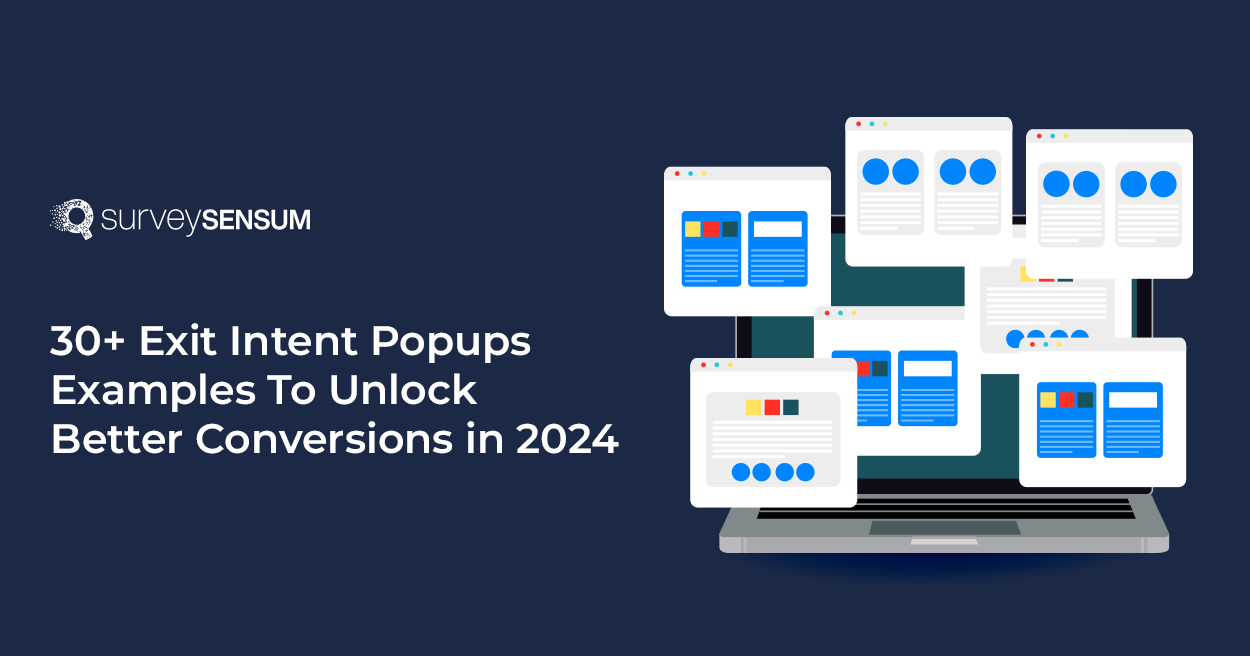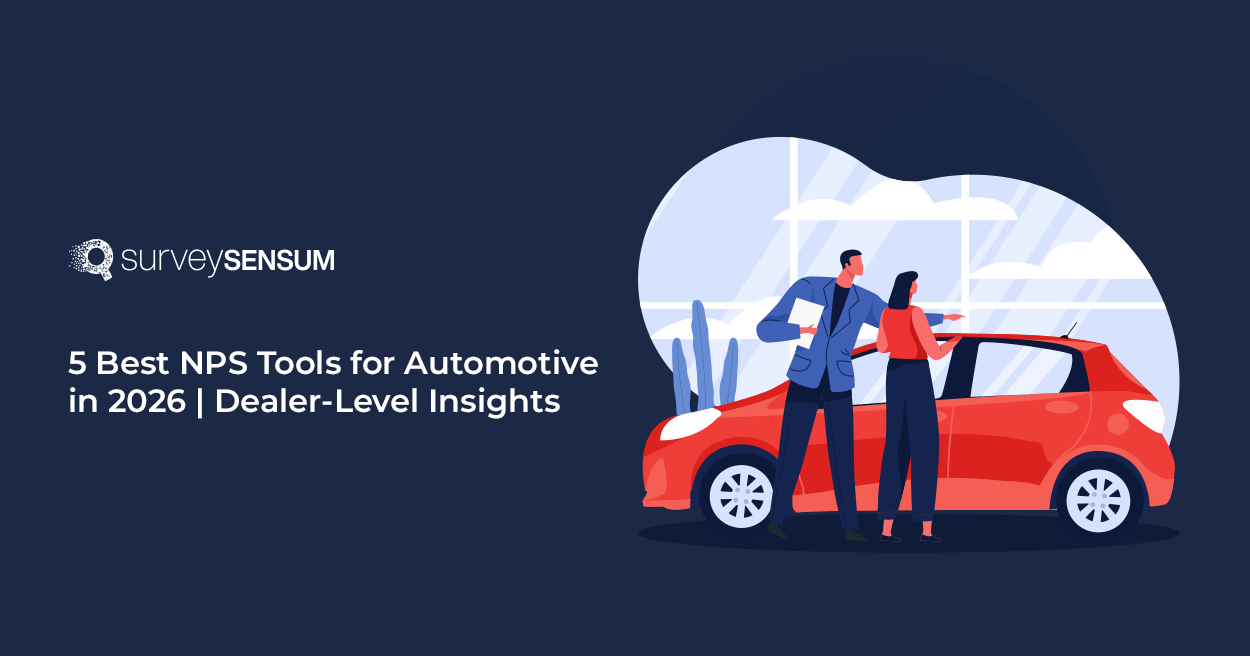

So last week I was browsing the internet to buy a new pair of earrings for one of my closest friends. After browsing for a while I landed on a website with an amazing jewelry collection. But after a while, I realized that the prices were a little too high for me and decided to exit. As I was about to close the tab, a pop-up emerged on my screen notifying me that I could get 5% off on my first purchase. Now, that is what I call good news! I immediately added one of the earrings to my cart, applied the discount code, and voila kept both my friend and wallet happy!
Now, I am sure this is not an isolated happy incident and if this sounds familiar, well then, you’re not alone!
Those pesky little windows are called exit pop-up surveys and can save between 10-15% of abandoning visitors. That’s right, those little popups hold immense power in the world of digital marketing and conversion.
In today’s hyper-competitive digital landscape, capturing and retaining the attention of your website visitors is more crucial than ever. Exit intent popups swoop in at the very moment when a user is about to leave your site, giving you one final chance to engage with them, offer something of value, and potentially turn that fleeting visit into a lasting conversion.
Sounds interesting? Then, let’s dive into the fascinating world of exit intent popups and learn why they are important, how to create effective pop-up survey design, with the help of a robust survey builder tool, and discover some examples of best exit intent popups.
Now, let’s begin with understanding what are exit intent pop-ups and why are they important.
What are Exit Intent Popups?
Exit intent popups are a type of website popup survey that is triggered when a visitor shows intent to leave the webpage. These popups are triggered by the user’s mouse movement, typically when it moves toward the top of the browser window to close the tab or navigate away from the site.
Once triggered, exit intent popups display a message or offer to the user in an attempt to capture their attention and encourage them to stay or take a specific action before leaving the site. These messages often include special offers, discounts, subscription prompts, or other incentives to engage the user and prevent them from leaving.
But are they really worth it? Let’s see.
Why Use Exit Intent Popups?
Exit intent popups are used for several reasons:
- Reduce bounce rates: When visitors are about to leave your website, an exit intent popup can grab their attention and potentially persuade them to stay longer or explore further. This helps reduce bounce rates, which is important for improving SEO and user engagement metrics.
- Increase conversions: According to research by OptiMonk, the average popup conversion rate is 11.09%. By presenting visitors, who are about to leave, with a compelling offer via popups, you can increase the likelihood of converting them into customers or subscribers.
- Capture leads: Exit intent popups are effective for capturing leads by prompting visitors to sign up for newsletters, download content, or create an account before they leave. This allows you to gather valuable contact information and continue engaging with them through email marketing or other channels.
- Improve user experience: By providing relevant and valuable content or offers, exit intent popups can enhance the overall user experience by offering something of value right when the user needs it.
Overall, exit intent popups are a strategic tool for engaging with visitors at a critical moment and maximizing the opportunities for conversion and quality lead generation on your website.
Now, that we know what are exit-intent popups and why you need to use them on your website, an interesting question arises here – do exit-intent popups work effectively on mobile or just desktop? Let’s find out.
Do Exit-Intent Popups Work on Mobile?
Tracking exit intent on mobile differs slightly from a website as there is no cursor movement to track. So, does that mean exit-intent popups don’t work on mobile? No, that’s not true. In fact, according to research done by Getsitecontrol, mobile popups engage on average 42.04% better than popups on desktop. It’s just that they do work but the technology to track them is different.
And here are a few ways you can trigger exit-intent popups on mobile devices, using an efficient exit-intent popup software.
- You can trigger a popup when someone scrolls up to a certain percentage of the mobile screen.
- You can also display a popup when they hit the back button.
- When they stay on the same page for a certain amount of time.
- When they leave the page idle for a certain amount of time.
Use these proven methods to run successful exit intent popups on mobile devices.
To boost conversion via popups, you need to listen to the voices of your customers and understand their preferences. So, launch popup surveys with SurveySensum and understand your customers better!
Now, that we understand the workings of exit intent popups, let’s explore some brand examples of these popups.
30+ Exit Intent Popup Examples (Brand Examples)
Here are the best brand examples of exit-intent popups that you can draw inspiration from.
1. Sign Up Popup – Nike
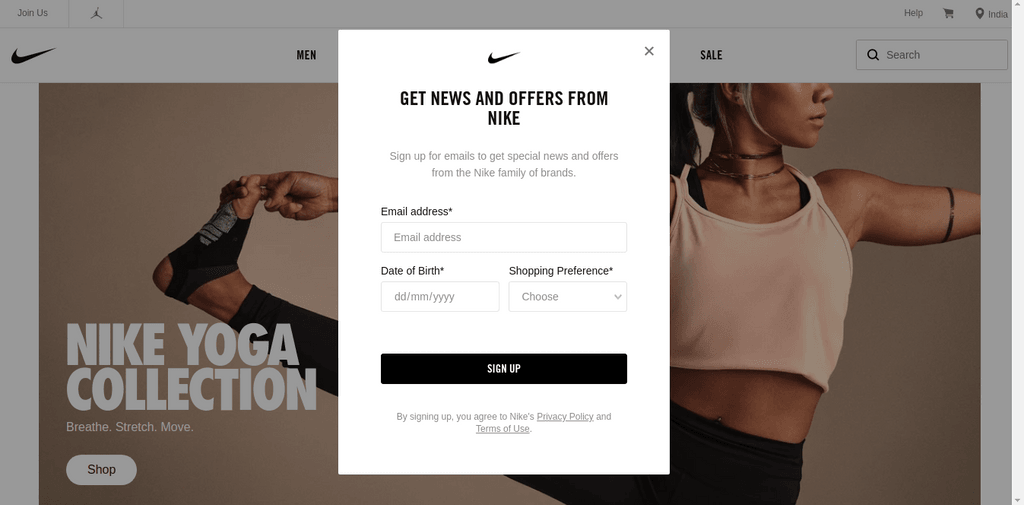
Type of exit-intent popup: Nike uses different types of engaging popups and one of the engaging ones is the sign-up popup.
Why this popup works: This type of popup incentivizes visitors with current updates, news, and special offers. This will surely encourage people to sign up and maybe use it in the future and this way Nike gets the visitor’s information that can be used for targeted marketing.
2. Cart Abandonment Popup – Scarlettos

Type of exit-intent popup: When visitors intend to leave Scarlettos’s website and abandon their shopping cart, the brand uses a cart abandonment popup with a special discount to incentivize visitors to continue shopping.
Why this popup works: Did you know that cart abandonment popups have a 17.12% conversion rate? This is because just when visitors are about to leave an incentive like a special discount or offer will encourage them to continue with purchasing.
3. Countdown Timer Popup – SwissWatchExpo

Type of exit-intent popup: The countdown timer popup by SwissWatchExpo includes a visual countdown timer that dynamically counts down the remaining time before a special offer, sale, or promotion expires.
Why this popup works: Did you know that the average conversion rate for popups with a countdown timer is 14.41%? This is because this tactic effectively taps into the psychological principle of scarcity, compelling users to reconsider their decision to exit and prompting them to take advantage of the time-sensitive opportunity presented.
4. Free Shipping Popup – Everlane

Type of exit-intent popup: The free shipping popup used by Everlane is a promotional exit-intent popup. When a user tries to leave the website, this popup appears offering free shipping on their order.
Why this popup works: By offering free shipping at the moment when users are about to leave, Everlane removes a significant barrier to completing the purchase. The offer of free shipping incentivizes users to reconsider their decision to leave and encourages them to proceed with their purchase, ultimately increasing conversion rates.
Launch exit-intent feedback surveys with SurveySensum to understand your customers’ needs, expectations, and preferences and cater your offerings to customers’ expectations!
5. Conversational Popup – Fundera

Type of exit-intent popup: The conversational popup used by Fundera is an interactive exit-intent popup that simulates a conversation between the user and a virtual assistant or chatbot.
Why this popup works: Did you that the average conversion rate of conversational popups is 15.2%? This popup works because it offers users a personalized and interactive experience that mimics human conversation. Users may feel more comfortable asking questions or seeking assistance in a conversational format, leading to increased engagement and potentially higher conversion rates.
6. Subscription Popup – Instapage

Type of exit-intent popup: The subscription popup used by Instapage is a lead generation exit-intent popup. It prompts users to subscribe to their newsletter or mailing list before leaving the website.
Why this popup works: This is effective because by inviting users to subscribe to their newsletter as they attempt to leave, Instapage ensures that they capture valuable leads and potential customers. Additionally, by offering exclusive content, updates, or promotions to subscribers, you can provide an incentive for users to sign up, further increasing the likelihood of conversion in the future.
7. Scratch & Win – Jewelscent
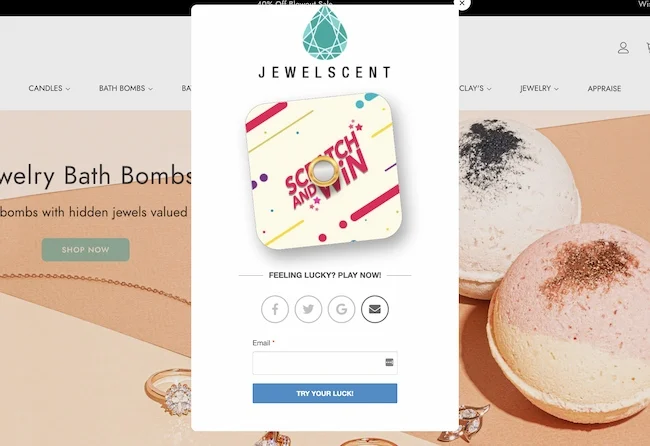
Type of exit-intent popup: The Scratch & Win popup used by Jewelscent is an interactive exit-intent popup. It presents users with a virtual scratch card that they can “scratch” to reveal a prize or discount.
Why this popup works: Did you know that gamified popups like “scratch & win” or “spin a wheel” generate a 13.23% average conversion rate? By gamifying the exit experience with a chance to win a prize or discount, you can create a fun and memorable interaction that increases user engagement and incentivizes them to stay on the site longer.
8. Giveaway Popup – Wildwood

Type of exit-intent popup: The giveaway popup used by Wildwood is an incentive-based exit-intent popup. It offers users the chance to enter a giveaway or contest before leaving the website.
Why this popup works: This popup is effective because it taps into the user’s desire for freebies and incentives. By offering the opportunity to enter a giveaway or contest, you provide your visitors with an additional reason to stay on the site and engage with their brand.
9. Image Popup – Omsom

Type of exit-intent popup: The image popup used by Omsom is a visual exit-intent popup. It displays an enticing image or visual content to capture the user’s attention before they leave the website.
Why this popup works: Did you that popups with images engaged 7.49% of visitors, whereas showing no images saw the number drop to 5.82%? Visual content is more likely to grab users’ attention and leave a lasting impression, making them more receptive to the brand’s message and offerings. Additionally, the image popup allows you to convey information or evoke emotions quickly.
10. Ebook Download Popup – Conversific

Type of exit-intent popup: The ebook download Popup used by Conversific is an informational exit-intent popup. It offers users the opportunity to download a free ebook or resource related to their products or industry.
Why this popup works: Did you that popups with lead magnets increase the average conversion rate to 7.73% on mobile and 4.7% on desktop? Offering a free ebook or resource creates a positive impression of the brand and encourages users to stay engaged with their content before leaving the site. Additionally, the offer of a free download incentivizes users to provide their contact information, allowing brands to capture leads and nurture them through targeted email marketing campaigns in the future.
Launch customer, product, and employee experience surveys with SurveySensum in just 10 minutes with survey templates and pre-design exit intent popups questions.
11. Membership Popup – Madewell

Type of exit-intent popup: The membership popup used by Madewell is an incentive-based exit-intent popup. It prompts users to join their membership program and avail different benefits of being a member before leaving the website.
Why this popup works: This popup works because it offers users a valuable incentive to stay engaged with the brand. By inviting users to join their membership program, you can provide exclusive benefits, rewards, or discounts that are only accessible to members. This creates a sense of exclusivity and incentivizes users to reconsider their decision to leave the site.
12. Email Subscription – Mimochai

Type of exit-intent popup: The email subscription popup used by Mimochai is a lead generation exit-intent popup. It prompts users to subscribe to their email list before leaving the website and this helps the brand to capture leads and provide them with new updates, sales, etc.
Why this popup works: This popup works because it captures users’ contact information and allows brands to nurture them through email marketing campaigns. By inviting users to subscribe to their email list, you can send them relevant content, updates, and promotions, keeping the brand top-of-mind and encouraging repeat visits and purchases.
13. Show Me a Demo – Zendesk

Type of exit-intent popup: The “Show Me a Demo” Popup used by Zendesk is an engagement-based exit-intent popup. It prompts users to request a product demo and a guide through how to use the product before leaving the website.
Why this popup works: This popup works because it offers users an opportunity to learn more about the products or services in a personalized and interactive way. Product demos allow users to experience the product firsthand and make more informed purchasing decisions, making them more likely to convert into paying customers.
14. Early Bird Offer – Flamingo
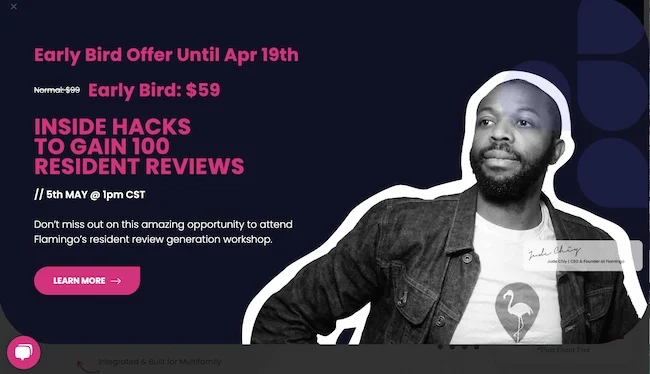
Type of exit-intent popup: The early bird popup used by Flamingo is a promotional exit-intent popup. It offers users a special discount or promotion for early adopters before leaving the website.
Why this popup works: The sense of exclusivity and limited availability associated with early bird offers makes users feel privileged and motivates them to take advantage of the opportunity while they can. Additionally, early bird promotions can help generate buzz, drive traffic, and increase sales during product launches or promotional campaigns.
15. Reminder Popup – Vintage Threads

Type of exit-intent popup: The reminder popup used by Vintage Threads is a notification-based exit-intent popup. It reminds users about items left in their shopping cart before leaving the website.
Why this popup works: This popup works because it helps reduce cart abandonment and encourages users to complete their purchases. Cart reminder popups capitalize on users’ intent to purchase and address common reasons for abandonment, such as distraction or indecision. By providing a convenient and timely reminder, you can increase the likelihood of conversion and recover potential lost sales.
16. Exit-Intent Popup Survey – Asana

Type of exit-intent popup: The exit-intent popup survey used by Asana is a feedback-based exit-intent popup. It invites users to provide feedback or complete a survey before leaving the website.
Why this popup works: Surveys provide a direct channel for users to voice their opinions and suggestions, making them feel valued and engaged with the brand. Additionally, by addressing users’ concerns and improving the user experience based on their feedback, you can enhance customer satisfaction, loyalty, and retention.
17. Spin a Wheel Popup – Crafted

Type of exit-intent popup: The spin-a-wheel popup used by Crafted is an interactive exit-intent popup. It presents users with a virtual wheel that they can spin to win prizes or discounts before leaving the website.
Why this popup works: This popup works because it gamifies the exit experience and creates a fun and engaging interaction with users. The element of surprise and the potential for winning something valuable make this popup more appealing to users, increasing their likelihood of engagement and conversion.
18. Free Product Popup – Snow

Type of exit-intent popup: The free product popup used by Snow is a promotional exit-intent popup. It offers users a free product or sample before leaving the website.
Why this popup works: Offering free products taps into users’ desire for freebies and incentives, making them more likely to engage with the brand and consider making a purchase in the future.
19. Free Cheatsheet Popup – Peak Freelance’s
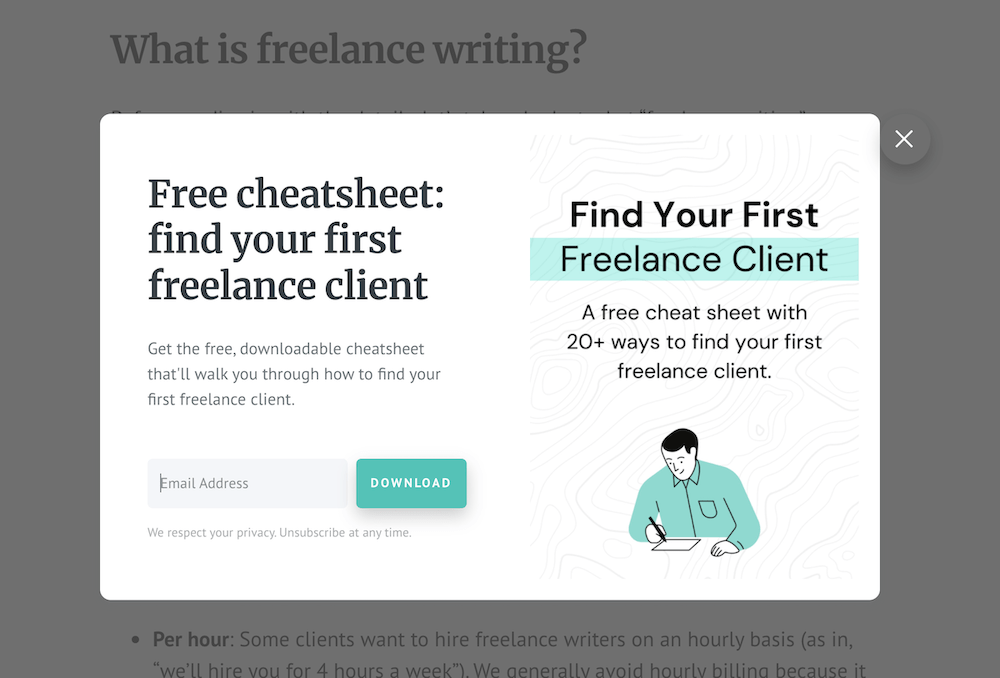
Type of exit-intent popup: The free cheatsheet popup used by Peak Freelance’s is an informational exit-intent popup. It offers users a free cheat sheet or resource related to their industry or expertise before leaving the website.
Why this popup works: This popup creates a positive impression of the brand and encourages users to stay engaged with your content before leaving the site. Additionally, the offer of a free download incentivizes users to provide their contact information, allowing brands to capture leads and nurture them through targeted marketing campaigns in the future.
20. Join the Club Popup – ConvertFlow
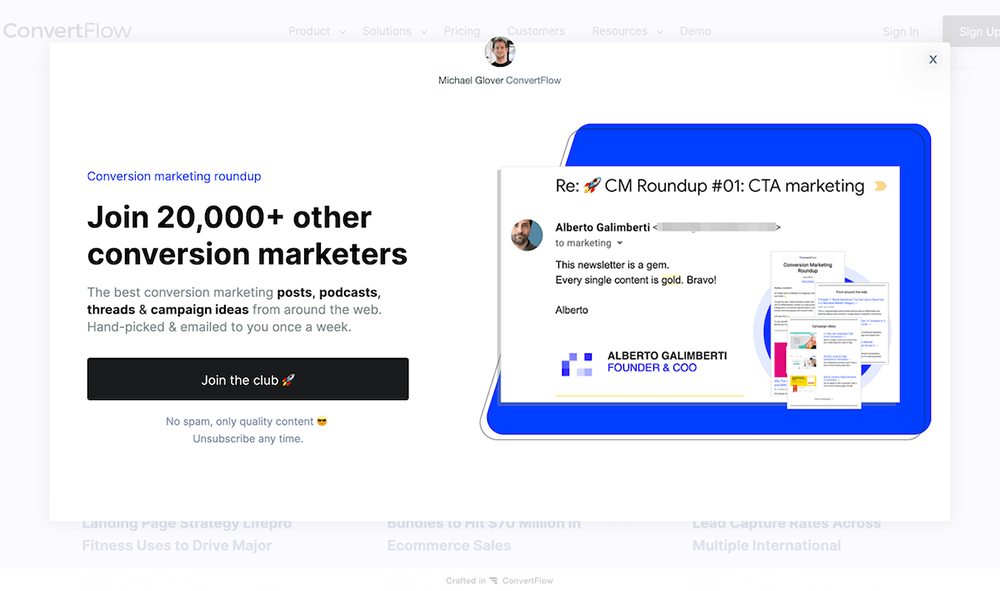
Type of exit-intent popup: The join the club popup used by ConvertFlow is an incentive-based exit-intent popup. It prompts users to join their community or membership program before leaving the website.
Why this popup works: This popup works because it offers users a sense of belonging and exclusivity. By becoming a member, users gain access to exclusive benefits, resources, or discounts, enhancing their experience with the brand and increasing their likelihood of engagement and loyalty.
21. Webinar Registration Popup – Neil Patel
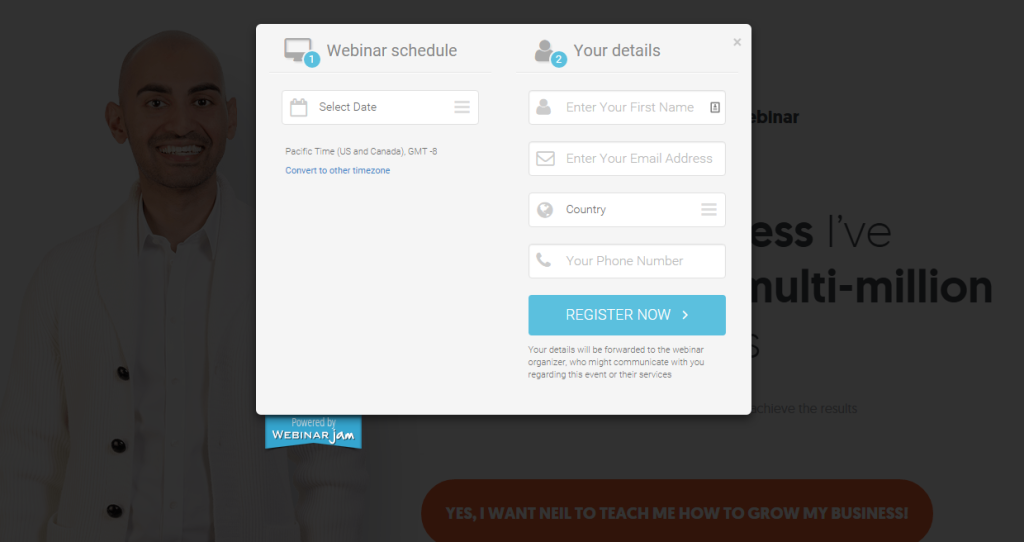
Type of exit-intent popup: The webinar registration popup used by Neil Patel is an engagement-based exit-intent popup. It prompts users to register for a webinar or online event before leaving the website.
Why this popup works: This popup works because it offers users an opportunity to learn from industry experts and gain valuable insights or skills. By inviting users to register for a webinar, you provide visitors with access to exclusive content and educational resources, positioning yourself as a trusted source of information and expertise.
22. Let’s Chat Popup – Sumo
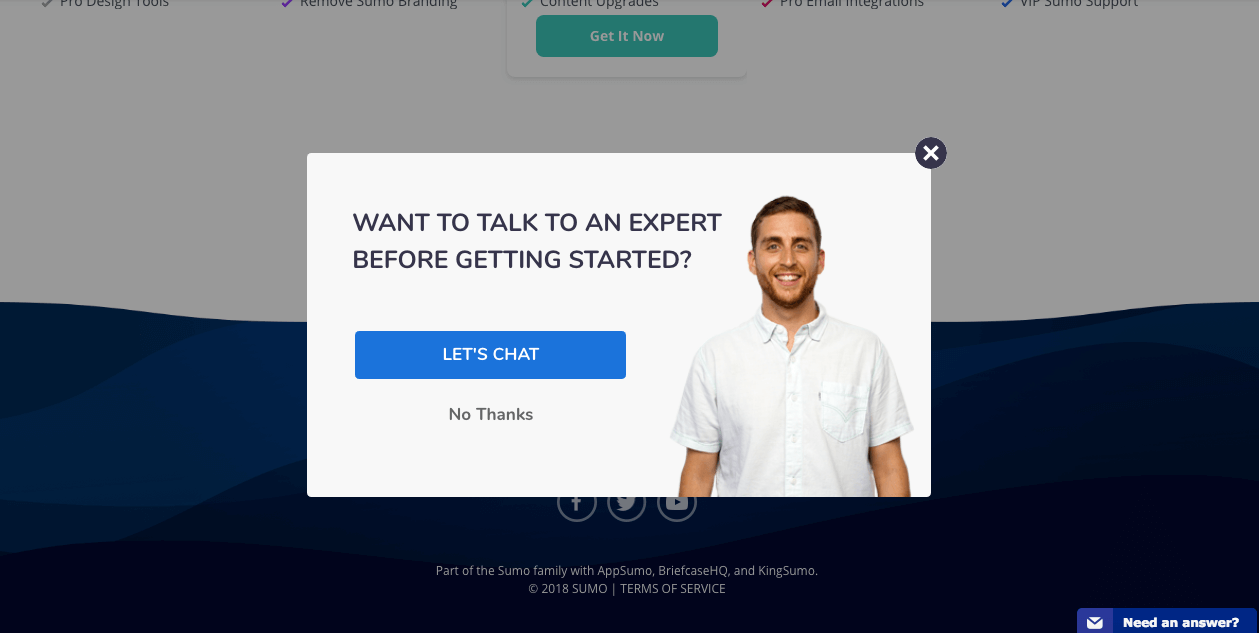
Type of exit-intent popup: The let’s chat popup used by Sumo is an engagement-based exit-intent popup. It invites users to initiate a live chat or conversation with a representative before leaving the website.
Why this popup works: This popup works because it provides users with immediate assistance and support at the moment when they need it most. Live chat allows for personalized and interactive communication between users and representatives, helping to build trust and rapport with the brand.
23. Launch a Contest Popup – Misen

Type of exit-intent popup: The launch a contest popup used by Misen is an engagement-based exit-intent popup. It invites users to participate in a contest or giveaway before leaving the website.
Why this popup works: This popup works because it creates excitement and incentivizes users to stay engaged with the brand. By launching a contest or giveaway, you can offer visitors the chance to win prizes or rewards, encouraging them to take action and stay on the site longer.
24. Offer on Next Purchase Popup – ProspectorKnives
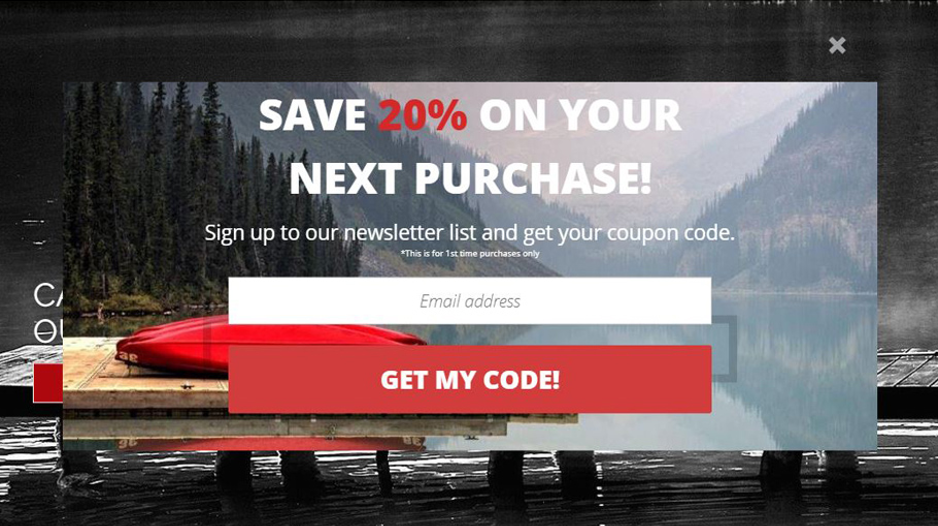
Type of exit-intent popup: The offer on the next purchase popup used by ProspectorKnives is a promotional exit-intent popup. It offers users a special discount or promotion for their next purchase before leaving the website.
Why this popup works: This popup works because it encourages users to make a repeat purchase and increases customer retention. The offer of a discount or promotion provides added value to users and creates a positive impression of the brand, encouraging them to take advantage of the offer before it expires.
25. Yes/No Popup – CharmsToTreasure
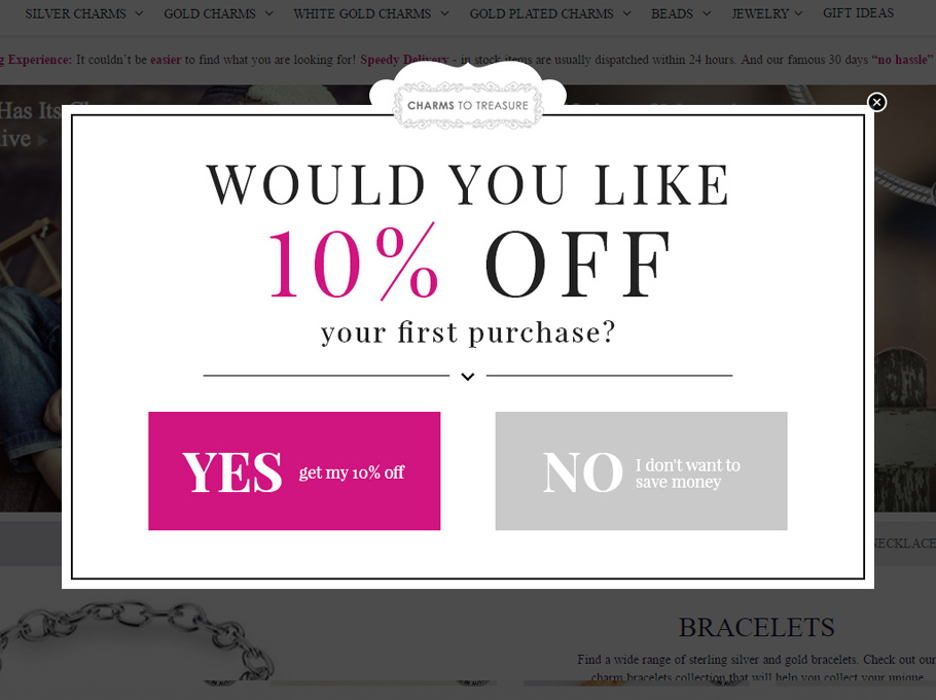
Type of exit-intent popup: The Yes/No popup used by CharmsToTreasure is an engagement-based exit-intent popup. It presents users with a binary choice or decision to make before leaving the website.
Why this popup works: This popup works because it prompts users to make a quick and decisive choice, increasing their engagement and likelihood of conversion. The binary choice format simplifies the decision-making process for users, reducing cognitive load and making it easier for them to respond.
26. First Order Discount Popup – Hey Meave

Type of exit-intent popup: The first order discount popup used by Hey Meave is a promotional exit-intent popup. It offers users a special discount or promotion for their first order before leaving the website.
Why this popup works: This popup works because it incentivizes users to make a purchase and increases conversion rates. The offer of a discount or promotion provides added value to users and creates a sense of urgency, prompting them to make a purchase and capitalize on the opportunity while it lasts.
27. Holiday Special Popup – EasyologyPets
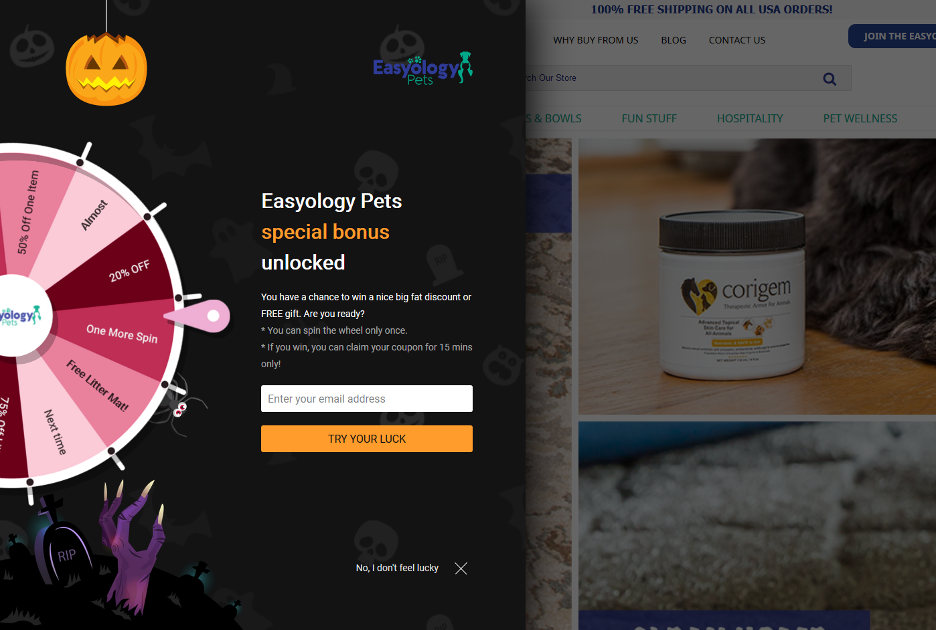
Type of exit-intent popup: The holiday special popup used by EasyologyPets is a promotional exit-intent popup. It offers users a special deal, promotion, or offer before leaving the website.
Why this popup works: This popup works because it provides users with a valuable incentive to stay engaged with the brand. The sense of exclusivity and limited availability associated with special deals or promotions creates a sense of urgency, motivating users to make a purchase or engage with the brand in some way.
28. Hottest Deals Popup – Beddingstock

Type of exit-intent popup: The hottest deals popup used by Beddingstock is a promotional exit-intent popup. It highlights the hottest deals or offers available on the website before users leave.
Why this popup works: This popup works because it showcases value-driven offers and incentivizes users to take action before leaving the site. The visual appeal and urgency associated with hot deals create a sense of excitement, prompting users to act quickly before the offers expire.
29. Capture Leads Popup – Scott’s Cheap Flights

Type of exit-intent popup: The capture leads popup used by Scott’s Cheap Flights is a lead generation exit-intent popup. It prompts users to subscribe to their email list before leaving the website.
Why this popup works: This popup works because it captures users’ contact information and allows brands to nurture them through email marketing campaigns. By inviting users to subscribe to your email list, you can send them relevant deals, updates, and promotions, keeping the brand top-of-mind and encouraging repeat visits and purchases.
30. Free Giveaways Popup – Ryan Robinson

Type of exit-intent popup: The free giveaway oopup used by Ryan Robinson is an incentive-based exit-intent popup. It offers users the chance to participate in a giveaway or contest before leaving the website.
Why this popup works: This popup works because it creates excitement and incentivizes users to stay engaged with the brand. Giveaways and contests generate buzz and excitement around the brand, attracting new visitors and increasing engagement and participation.
These examples demonstrate various approaches to using exit popups to engage users, reduce cart abandonment, and drive conversions. Use them as inspiration to create effective exit popup strategies for your own brand.
Let’s also talk about some best practices to follow while creating exit-intent popups.
How to Use Exit Intent Popups Effectively: Best Practices
If used correctly exit-intent popups can be like a new and exciting twist in a boring movie plot. So, let’s explore some of the best practices and strategies you can use to create successful exit intent popups and boost your conversion rate.
- Offer Value: Offer visitors something irresistible – whether it’s a juicy discount, an exclusive download, or a chance to win a coveted prize. Make them think, “Wait, I definitely don’t want to miss out on this!”
- Timing is Key: Trigger the exit-intent popup at the right moment to capture attention without interrupting the user experience. Aim to display the popup when users demonstrate exit intent, such as moving their cursor toward the browser’s close button.
- Popup Surveys: Along with exit-intent popups, also launch popup surveys. These surveys are a fun and interactive way to connect with your customers in real-time. You can capture customer feedback in real-time, just as your customers are experiencing it.
- Choose the Right Image: Let’s say you want to display a “scratch & win” popup but your popup is showing the image of “spin a wheel”, now that’s confusing, right? So, display an image that communicates your message effectively.
- A/B Testing: Experiment with different popup designs, messaging, and timing to determine what resonates best with your audience and drives higher conversion optimization. Conduct A/B tests to compare the performance of different variations and optimize for even better results.
- Clear Call to Action: Clearly communicate the action you want visitors to take, whether it’s subscribing to a newsletter, making a purchase, or accessing exclusive content. Use persuasive language and design elements to encourage clicks.
- Provide an Exit Option: Offer visitors a clear and easy way to dismiss the popup if they’re not interested. Include a visible close button or option to continue browsing without taking action. This will enhance their user experience as they won’t feel like being forced to click yes.
By following these best practices, you can leverage exit-intent popups effectively to engage visitors, reduce bounce rates, and drive conversions on your website.
Conclusion
Exit-intent popups are powerful tools for engaging website visitors, reducing bounce rates, and driving conversions. With creativity, empathy, and a deep understanding of visitor behavior, exit-intent popups can transform fleeting exits into valuable opportunities to connect, engage, and delight audiences, ultimately leading to increased engagement, conversions, and brand loyalty.






